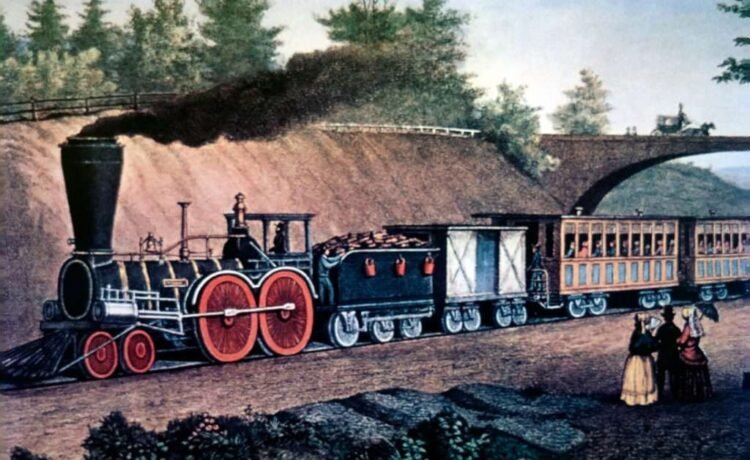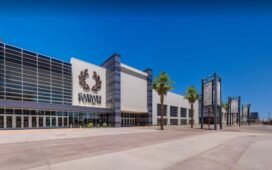
 What follows is an article published in the Sydney Morning Herald of New South Wales, Australia on January 23, 1852. Chartered in 1846, the Hudson River Railroad was built to connect the Troy and Greenbush Railroad with the city of New York.
What follows is an article published in the Sydney Morning Herald of New South Wales, Australia on January 23, 1852. Chartered in 1846, the Hudson River Railroad was built to connect the Troy and Greenbush Railroad with the city of New York.
On Wednesday, [October 3, 1851] the ceremony took place of opening the Hudson River Railroad, in its entire length from New York to Albany. Hitherto the portion of the road between Poughkeepsie and Tivoli [in Dutchess County] (twenty-six miles) was not in operation, and the passengers were conveyed in a steamboat between those two points. Last week the road was completed, and the cars ran over it privately. Last week it was [also] publicly opened, by running two excursion trains each way and returning.
The first train from New York started from Chambers street at six o’clock, being drawn by horses to Thirty-first street, whence it proceeded at half-past 6 o’clock, and, stopping at Manhattan, 152nd street, Yonkers, Hastings [in Westchester County], Dobbs’ Ferry, Tarrytown, Sing Sing, Peekskill, Cold Spring, Fishkill, New Hamburg, Poughkeepsie, Hyde Park, Rhinebeck, Oakhill, Hudson, Stuyvesant, Castleton, ought to have arrived at East Albany at 11:15 am, but did not arrive till 11:35 am.

 This was the way train [i.e., the train making all the stops]. The through [express] train started at 7 o’clock am, from Chambers street, leaving Thirty-first street at half-past 7 am, and stopping at Peekskill at 8:30; Poughkeepsie at 9:30; Rhinebeck at 9:55; Hudson at 10:40, arriving at East Albany at twenty-five minutes past 11 o’clock, being four hours and twenty-five minutes from Chambers-street, or five minutes less than four hours from Thirty-first street.
This was the way train [i.e., the train making all the stops]. The through [express] train started at 7 o’clock am, from Chambers street, leaving Thirty-first street at half-past 7 am, and stopping at Peekskill at 8:30; Poughkeepsie at 9:30; Rhinebeck at 9:55; Hudson at 10:40, arriving at East Albany at twenty-five minutes past 11 o’clock, being four hours and twenty-five minutes from Chambers-street, or five minutes less than four hours from Thirty-first street.
Two similar trains started from the Albany terminus [located in what is now Rensselaer] at the same hours, making the same stoppages and making nearly equal time. When the new portion of the road – especially as much of it as runs over the river on piles and embankments – settles down and becomes firm, the distance will be accomplished in still less time than it was on Wednesday last.
The oscillation of the cars was considerable over the new portions of the road; but this was to be expected. On all other parts of the road, riding is as smooth as upon any railroad in the United States. One portion of the line extends for four miles over water, in a single stretch.
The entire length of the road, from Chambers street to Albany, is 143 miles. As a general feature, it may be observed that the work is constructed along the eastern bank of the river, five feet above high tides.
The grades are excellent, there being, of the entire distance, 114 miles upon a dead level; five miles, from one to five feet per mile; thirteen miles, of ten feet per mile, and five miles, of thirteen feet per mile inclination, which is the worst grade upon the road. The total rise and fall is 213 feet only.
The whole number of curves is 279, there being 56 miles of curved line. The shortest curve is at Peekskill, which is of 1,000 feet radius, while more than half the whole number are from 4,000 to 10,000 feet radius.
The rock excavation is immense, a very large proportion of the road being hewn out of the solid rock, along the water’s edge, besides the following eight tunnels:

 Oscawana or Peg’s Island, 225 feet
Oscawana or Peg’s Island, 225 feet
Abbott’s Point (bridge tunnel), 100′
Flat Rock, 70′
Anthony’s Nose, 400′
Garrison’s at Phillips’ Hill, 900′
Breakneck Hill, 400′
New Hamburg, 1,400′
Milton Ferry, 100′
Total length, 3,595 feet
The total amount of rock-cutting is nearly two millions of cubic feet. On the Highland division, above Fishkill to Peekskill, a distance of sixteen miles, over 425,000 cubic yards of rock were excavated.
The whole cost of this railroad will be about nine millions of dollars. The original stock subscribed amounted to 3,016,600 dollars, in 30,165 shares. The road was opened on the 29th September, 1849, between New York and Peekskill, a distance of forty miles; on the 6th December to Hamburg, and on the 31st to Poughkeepsie.
On Wednesday the whole line was not only opened to Albany, but a feat of speed was accomplished that our ancestors would have laughed at as the wildest absurdity, and Fulton himself among the number.

 Nay, ten years ago a railroad to Albany was considered one of the most impracticable of ideas, and the wise men of Wall street scouted it as perfectly visionary. But the progress of science is not to be calculated by the men of dollars and cents.
Nay, ten years ago a railroad to Albany was considered one of the most impracticable of ideas, and the wise men of Wall street scouted it as perfectly visionary. But the progress of science is not to be calculated by the men of dollars and cents.
Some fifty years ago it took two or three days, and sometimes four days, to accomplish the distance. Now it can be done in as many hours.
It is mentioned in the papers of 1797, as an instance of remarkable despatch, that Colonel William Colbreath, Sheriff of Herkimer County, left Albany on Sunday morning, May 7, on board a vessel for New York, and returned on Thursday afternoon, 11th, having in a little more than four days, including a day and a half he was in New York, performed a journey of 330 miles.
The mail stages in winter, till steamboats were established, took from thirty-six to forty-eight hours in winter, and the fare was 10 dollars.
Fulton ran his boat, which the whole world ridiculed, on the 1st of October, 1807, just forty-four years ago, when he accomplished the distance in thirty-three hours, or as some say in twenty-eight hours.
This was considered a wonderful feat at that time. But the [steamboats] Isaac Newton and the Reindeer have long since eclipsed it, and the performance of the iron horse on Wednesday, three hours and forty minutes from Albany, has distanced them still further. What next?
A more delightful season, or a more beautiful day, could not have been selected for this celebration. It was one of those days peculiar to Indian summer – calm, soft, and genial, and the air like balm.

 The glorious Hudson was like a mirror – not a breath of wind rippled its burnished surface, in which was reflected the trees of many hues that clothe its picturesque banks, and the numerous craft, with their snow-white sails spread in vain to catch the unwilling breeze, and all seeming as motionless as “painted ships upon a painted ocean.”
The glorious Hudson was like a mirror – not a breath of wind rippled its burnished surface, in which was reflected the trees of many hues that clothe its picturesque banks, and the numerous craft, with their snow-white sails spread in vain to catch the unwilling breeze, and all seeming as motionless as “painted ships upon a painted ocean.”
Perhaps there is not at this season of the year any scenery in the world to compare with that of the Hudson, from New York to Albany. In summer it has its charms, but what are these compared with the gorgeous glories of the autumnal tints that now burst upon the delighted vision on either hand?
Wednesday, the trees of the Hudson presented the appearance of a gigantic flower garden, extending nearly 150 miles, and exhibiting in all their rich variety and mellowness, those hues which the brightest parterre cannot equal, and which cast completely into the shade the boasted scenery of the Rhine, and all the forest scenery of the old world put together.
Such is its grandeur and beauty, that Europeans have no conception of it, even from what they read, and they are lost in mute astonishment and wonder when they beheld for the first time, those matchless pictures, painted by nature’s pencil.
The most glowing description is cold and feeble when compared with the reality of the autumnal scenery on the banks of the Hudson, which is now in all its glory.
Nor ought the magnificent Palisades, or the smiling beautiful villages, basking in an unclouded sun be omitted from a description of the landscapes of that noble river which derives its name from Hendrick Hudson, who discovered it nearly two centuries and a half ago.
At all the stopping places along the line there were crowds of people assembled, who loudly cheered, and discharged firearms, great and small. The demonstrations at Peekskill, Poughkeepsie and Hudson, were greater than at the other villages.
At Hudson, the orphans turned out in procession, and sung a ditty in honor of the occasion. They bore a flag, with the following inscription: “Boorman the friend of the orphan.”
[James Boorman (1783-1866) was director, a vice-president and president of the Hudson River Railroad Company. He was a great supporter of the Protestant “half-orphan asylum” – for children who had lost one parent – in the city of New York, among others.]
The number of well dressed ladies here was very large. The second train overtook the first at Hudson, and went out before it.
Near New Hamburg [in Dutchess County] as the trains passed, the [steamboats] Isaac Newton and the Oregon were observed to be aground, and the directors of the railroad hailed the incident as showing the superiority of steam on terra firma above steam on water.
All the officers of the company were on the train, including William C. Young, Esq., who was this week elected president, E. Jones, Esq., Vice President, J. M. Hopkins, Esq., Treasurer, C. H. Lee, Esq., Secretary and Acting Superintendent. Of the Directors, we noticed E. D. Morgan, Esq. [probably future NYS Governor Edwin D. Morgan], and H. M’Cullagh. There were several officers and directors of other railroad companies.

 On the arrival of the train at Greenbush [now Rensselaer, NY], there was an immense concourse of persons there from Albany and other parts of the State. There was a band in attendance, which welcomed the excursionists with its merry music and volley after volley of artillery boomed across the river.
On the arrival of the train at Greenbush [now Rensselaer, NY], there was an immense concourse of persons there from Albany and other parts of the State. There was a band in attendance, which welcomed the excursionists with its merry music and volley after volley of artillery boomed across the river.
The engine house was set apart as the place of entertainment for the guests, and was tastefully decorated with flags and evergreens. It was filled with tables, which were elegantly laid out, the head table being on the turn-table of the building, which is of a circular form.
Seats and plates were laid for 1,002 persons, and a number were still standing, who could not be accommodated. A magnificent dinner was served, and champagne flowed in abundance, while a band discoursed excellent music.
The entertainment was given by the directors and officers of the Board of the Common Council and heads of departments of the City of New York, the authorities of Albany and Troy, the shareholders of the road, and a large number of other invited guests.
Cornelius Vanderbilt obtained control of the Hudson River Railroad in 1864, soon after he bought the parallel New York and Harlem Railroad, which had opened from New York to Albany in 1852.
On November 1, 1869, Vanderbilt merged the Albany to Buffalo New York Central Railroad with his Hudson River Railroad to form the New York Central and Hudson River Railroad. In 1914, the route became part of the newly expanded and re-formed New York Central Railroad (New York Central Lines) which merged with the Pennsylvania Railroad in 1968.
Read more about railroad history in New York State.
George A. Thompson of the Hudson River Maritime Museum found and transcribed this article. It has been only slightly edited for clarity and annotated by John Warren.
Illustrations, from above: A typical train of the 1840s and 1850s; Hudson River and the Hudson River Railroad: with a complete map and wood cut views of the principal objects of interest upon the line, the first published guide to the Hudson River Railroad, 1851; Detail from “View on the Hudson River at Anthony’s Nose,” Holden’s Magazine, 1851; the “New York,” which drew the first train from New York to Albany on the Hudson River Railroad, weighed 22 tons and pulled wooden cars over 40 miles per hour; Currier and Ives, The Express Train, lithograph, 1870; and “View of Greenbush Station from Albany,” 1851, from Hudson River and the Hudson River Railroad.









Recent Comments